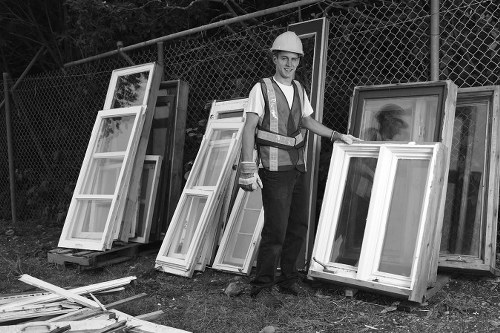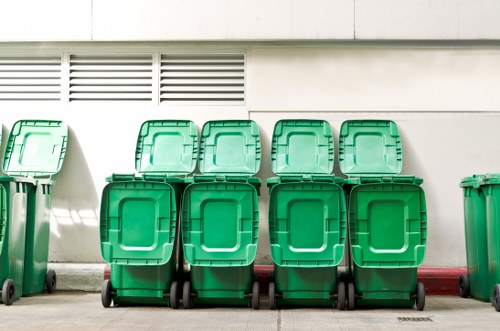Builders Waste Clearance in Cranford

Embarking on a construction or renovation project in Cranford? One crucial aspect to consider is effective builders waste clearance. Proper waste management not only ensures a clean and safe environment but also complies with local regulations.
Handling construction debris can be overwhelming, especially without the right resources and knowledge. This comprehensive guide explores the best practices and services available for managing builders waste in Cranford.
From understanding what constitutes builders waste to choosing the right clearance service, we've got you covered. Let’s delve into the essentials of efficient waste clearance for your next project.
What is Builders Waste?

Builders waste includes all the materials left over from construction, renovation, and demolition projects. This can range from concrete and bricks to timber and metal scraps.
Proper classification of builders waste is the first step towards effective clearance. Understanding the different types helps in determining the appropriate disposal methods.
Here are the main categories of builders waste:
- Construction Debris: Includes materials like bricks, concrete, and tiles.
- Wood Waste: Consists of timber scraps, pallets, and untreated wood.
- Metal Scraps: Encompasses items like steel beams and aluminum cans.
- Plastics and Polymers: Covers plastics used in construction, such as PVC pipes.
- Hazardous Waste: Includes materials like asbestos, lead-based paints, and certain chemicals.
Importance of Proper Waste Clearance

Efficient waste clearance is vital for several reasons. Firstly, it maintains the cleanliness and safety of the construction site, reducing the risk of accidents and injuries.
Secondly, proper disposal of builders waste helps in protecting the environment by minimizing the impact of construction activities.
Lastly, adhering to local waste management regulations in Cranford prevents legal repercussions and potential fines.
Steps for Effective Builders Waste Clearance

1. Planning and Assessment
Before commencing any clearance, assess the volume and type of waste generated. Planning helps in selecting the appropriate disposal methods and services.
2. Segregation of Waste
Separate different types of waste to facilitate recycling and proper disposal. Segregation reduces the overall volume of waste and makes recycling more efficient.
3. Choosing the Right Clearance Service
Select a reputable waste clearance company that offers comprehensive services tailored to your project’s needs. Ensure they comply with Cranford’s waste management regulations.
Choosing a Builders Waste Clearance Service in Cranford

When selecting a waste clearance service, consider the following factors:
- Experience: Choose a company with a proven track record in handling builders waste.
- Licensing and Certifications: Ensure the service provider is licensed and adheres to local waste disposal laws.
- Range of Services: Opt for companies that offer a wide range of clearance options, including recycling and hazardous waste management.
- Customer Reviews: Check reviews and testimonials to gauge the company’s reliability and quality of service.
- Cost: Compare prices to ensure you are getting value for your money without compromising on quality.
Environmental Impact of Builders Waste

Construction projects significantly contribute to environmental pollution if waste is not managed properly. Materials like concrete and metals take years to decompose, occupying valuable landfill space.
Recycling builders waste not only reduces the environmental footprint but also conserves natural resources. Many materials can be reused in future projects, promoting sustainable construction practices.
Moreover, proper waste management minimizes pollution, safeguarding local ecosystems and public health in Cranford.
Regulations and Compliance

Adhering to waste management regulations is crucial for any construction project in Cranford. Non-compliance can result in hefty fines and project delays.
Understanding the local laws regarding waste disposal ensures that your project runs smoothly and sustainably. It is advisable to consult with a waste management professional to navigate these regulations effectively.
Key compliance areas include:
- Proper documentation and permits for waste disposal
- Segregation and labeling of different waste types
- Timely removal and transportation of waste to authorized facilities
Recycling Builders Waste

Recycling is a pivotal aspect of builders waste clearance. It involves processing used materials to create new products, thereby reducing the need for raw materials.
Commonly recycled builders waste includes:
- Metal: Recycled metals can be used in manufacturing new construction materials.
- Wood: Untreated wood can be repurposed for various applications.
- Concrete: Crushed concrete is often used as a base for new construction projects.
- Plastics: Recycled plastics contribute to the production of new building materials.
Implementing recycling practices not only helps the environment but can also be cost-effective in the long run.
Benefits of Professional Builders Waste Clearance

Hiring professionals for builders waste clearance offers numerous advantages:
- Efficiency: Experienced companies can clear waste swiftly, keeping your project on schedule.
- Safety: Professionals are trained to handle hazardous materials safely, reducing risks on-site.
- Cost-Effective: Although it might seem costly initially, professional clearance can save money by preventing fines and reducing material disposal costs.
- Environmental Responsibility: Professional services ensure that waste is disposed of or recycled in an eco-friendly manner.
DIY vs. Professional Clearance

While DIY waste clearance might seem like a cost-saving approach, it often falls short of efficacy and compliance.
Pros of DIY:
- Potential cost savings
- Full control over the process
Cons of DIY:
- Lack of expertise in handling hazardous waste
- Time-consuming
- Potential for non-compliance with regulations
- Higher long-term costs due to fines and inefficiencies
In contrast, professional services offer expertise, efficiency, and peace of mind, ensuring that your builders waste clearance is handled correctly.
Cost Factors in Builders Waste Clearance

The cost of builders waste clearance in Cranford depends on several factors:
- Volume of Waste: Larger projects generate more waste, increasing disposal costs.
- Type of Waste: Hazardous materials require special handling, which can be more expensive.
- Service Frequency: Regular clearance services may offer discounted rates compared to one-time cleanups.
- Location: Accessibility of the site can impact transportation costs.
- Recycling Needs: If a significant portion of the waste is recyclable, it might reduce overall disposal costs.
Choosing the Right Disposal Method

Selecting the appropriate disposal method is essential for effective waste management. The choice depends on the type and volume of waste, as well as environmental considerations.
Common disposal methods include:
- Landfill Disposal: Suitable for non-recyclable and non-hazardous waste.
- Recycling: Preferred for materials that can be repurposed, such as metals and plastics.
- Hazardous Waste Disposal: Requires specialized handling and facilities.
- Composting: Ideal for biodegradable waste like certain types of wood and plant materials.
Consulting with a waste clearance professional ensures that you choose the most suitable and compliant disposal method for your builders waste.
Scheduling Builders Waste Clearance

Proper scheduling of waste clearance is crucial to maintain an organized and efficient construction site. Here are some tips:
- Plan Ahead: Schedule waste clearance in alignment with different phases of the project.
- Regular Intervals: Set up routine clearance schedules to prevent waste accumulation.
- Emergency Services: Choose a service that offers flexibility for unexpected waste surges.
- Coordination: Communicate with your clearance service to ensure timely pickups and avoid delays.
Effective scheduling contributes to a smoother workflow and minimizes disruptions on-site.
Innovations in Builders Waste Clearance

The waste management industry is evolving with new technologies and practices aimed at improving efficiency and sustainability.
Some notable innovations include:
- Automated Sorting Systems: Enhance the accuracy and speed of waste segregation.
- Eco-Friendly Disposal Methods: Focus on reducing environmental impact through advanced recycling techniques.
- Digital Tracking: Utilize software to monitor waste movement and ensure compliance with regulations.
- Green Certifications: Encourage companies to adopt sustainable practices and earn certifications for eco-friendly operations.
Staying abreast of these innovations can help you choose a forward-thinking waste clearance service that aligns with modern sustainability goals.
Final Thoughts on Builders Waste Clearance

Efficient builders waste clearance is a critical component of any construction or renovation project in Cranford. It ensures a safe, clean, and compliant worksite while promoting environmental sustainability.
By understanding the types of builders waste, adhering to regulations, and choosing the right clearance service, you can streamline your project and contribute to a greener future.
Don’t let waste management be a hurdle in your construction journey. Contact us today to book your builders waste clearance service and ensure your Cranford project stays on track and eco-friendly.
